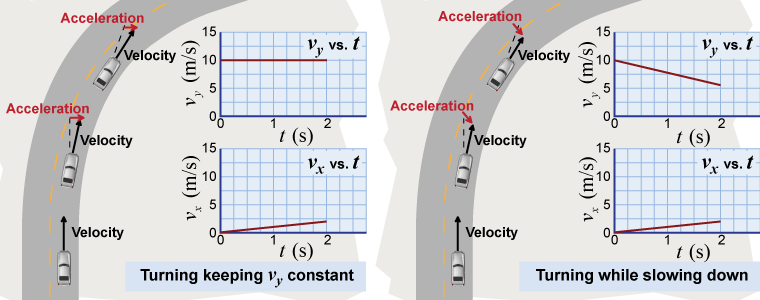|
Force, displacement, and velocity are vectors so it should be no surprise that acceleration is also a vector. Objects may accelerate and change their velocity in any direction, x, y, or z, including any combination of ax-, ay-, or az-component accelerations. Acceleration is the change in velocity over the change in time. 
|
| (6.5) | | | | = | acceleration (m/s2) | | Δv | = | change in velocity (m/s) | | Δt | = | change in time (s) |
| Acceleration
vector definition |
|
This equation is really shorthand for three component equations, one for each of the three coordinate axes: | |

|
The acceleration vector can be difficult to understand because it represents the rate of change in the velocity vector—which itself represents the rate of change in the position vector. Consider the following two cases of constant acceleration where the acceleration vector points in a different direction from the velocity. 
|
What does the motion look like if an object has an acceleration in one direction but not in another? In the example on the lower left, the initial velocity is equal to = (0, 10) m/s north, while the acceleration vector points due east at = (1, 0) m/s2. After one second, the velocity vector equals = (1, 10) m/s; after two seconds, = (2, 10) m/s. Notice that the y-component of the velocity stays the same, because there is no acceleration in the y-direction! This means that the speed is slowly increasing and the direction is turning more to the east every second. 
|

|
In a more realistic scenario, the car starts with the same velocity = (0, 10) m/s, but it slows down while turning (above right). The acceleration = (1,−2) m/s2 acts to slow the car down in the y-direction. After one second the velocity is = (1, 8) m/s, while after two seconds = (2, 6) m/s. Notice that the y-component of the velocity decreases by 2 m/s each second. The speed decreases over time and the direction changes. 
|
The illustration above depicts the motion using both graphical and vector models. Do you find that one is one more informative than the other? 
|
For the car that is slowing down while turning, what is its velocity after 5 s? What is its speed?
 |
The car's velocity starts at = (0,10) m/s and changes by (1,−2) m/s every second. After 5 s, the velocity has become = (5,0) m/s.
The speed is the magnitude of the velocity. Since the velocity has only an x-component, the speed is also 5 m/s. It has slowed down! 
|
| |
|

